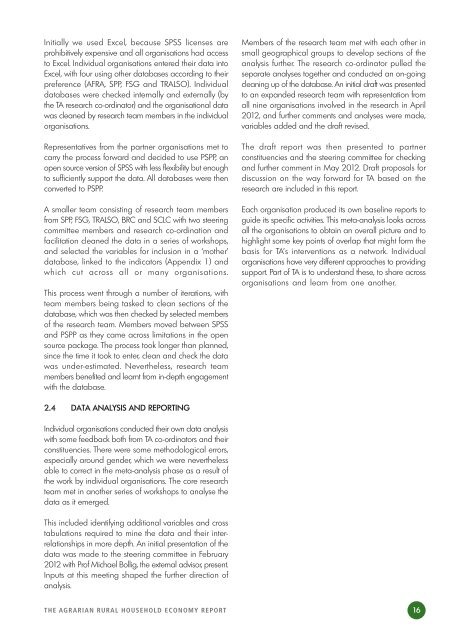THE AGRARIAN RURAL HOUSEHOLD ECONOMY
THE AGRARIAN RURAL HOUSEHOLD ECONOMY
THE AGRARIAN RURAL HOUSEHOLD ECONOMY
Create successful ePaper yourself
Turn your PDF publications into a flip-book with our unique Google optimized e-Paper software.
Initially we used Excel, because SPSS licenses are<br />
prohibitively expensive and all organisations had access<br />
to Excel. Individual organisations entered their data into<br />
Excel, with four using other databases according to their<br />
preference (AFRA, SPP, FSG and TRALSO). Individual<br />
databases were checked internally and externally (by<br />
the TA research co-ordinator) and the organisational data<br />
was cleaned by research team members in the individual<br />
organisations.<br />
Representatives from the partner organisations met to<br />
carry the process forward and decided to use PSPP, an<br />
open source version of SPSS with less flexibility but enough<br />
to sufficiently support the data. All databases were then<br />
converted to PSPP.<br />
A smaller team consisting of research team members<br />
from SPP, FSG, TRALSO, BRC and SCLC with two steering<br />
committee members and research co-ordination and<br />
facilitation cleaned the data in a series of workshops,<br />
and selected the variables for inclusion in a ‘mother’<br />
database, linked to the indicators (Appendix 1) and<br />
which cut across all or many organisations.<br />
This process went through a number of iterations, with<br />
team members being tasked to clean sections of the<br />
database, which was then checked by selected members<br />
of the research team. Members moved between SPSS<br />
and PSPP as they came across limitations in the open<br />
source package. The process took longer than planned,<br />
since the time it took to enter, clean and check the data<br />
was under-estimated. Nevertheless, research team<br />
members benefited and learnt from in-depth engagement<br />
with the database.<br />
2.4 DATA ANALYSIS AND REPORTING<br />
Individual organisations conducted their own data analysis<br />
with some feedback both from TA co-ordinators and their<br />
constituencies. There were some methodological errors,<br />
especially around gender, which we were nevertheless<br />
able to correct in the meta-analysis phase as a result of<br />
the work by individual organisations. The core research<br />
team met in another series of workshops to analyse the<br />
data as it emerged.<br />
This included identifying additional variables and cross<br />
tabulations required to mine the data and their interrelationships<br />
in more depth. An initial presentation of the<br />
data was made to the steering committee in February<br />
2012 with Prof Michael Bollig, the external advisor, present.<br />
Inputs at this meeting shaped the further direction of<br />
analysis.<br />
<strong>THE</strong> <strong>AGRARIAN</strong> <strong>RURAL</strong> <strong>HOUSEHOLD</strong> <strong>ECONOMY</strong> REPORT<br />
Members of the research team met with each other in<br />
small geographical groups to develop sections of the<br />
analysis further. The research co-ordinator pulled the<br />
separate analyses together and conducted an on-going<br />
cleaning up of the database. An initial draft was presented<br />
to an expanded research team with representation from<br />
all nine organisations involved in the research in April<br />
2012, and further comments and analyses were made,<br />
variables added and the draft revised.<br />
The draft report was then presented to partner<br />
constituencies and the steering committee for checking<br />
and further comment in May 2012. Draft proposals for<br />
discussion on the way forward for TA based on the<br />
research are included in this report.<br />
Each organisation produced its own baseline reports to<br />
guide its specific activities. This meta-analysis looks across<br />
all the organisations to obtain an overall picture and to<br />
highlight some key points of overlap that might form the<br />
basis for TA’s interventions as a network. Individual<br />
organisations have very different approaches to providing<br />
support. Part of TA is to understand these, to share across<br />
organisations and learn from one another. .<br />
16


